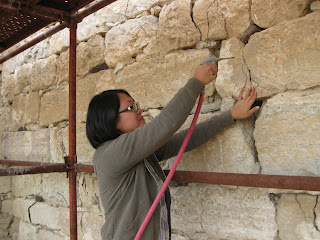 |
| Gordion site conservators at work. Photo by Andrea Berlin. |
An average visit to Gordion will include three stops: the museum, the Midas Tumulus, and the site located on the mound. For the last few seasons, Frank Matero and his students at the University of Pennsylvania programs in Architecture and Historic Preservation have been diligently working on preserving the site.
This season, site conservation projects include the installation of viewing pavilions, documentation, soft capping, and stabilizing the stone walls of the site. Objects conservation intern Lily Doan was able to join the site conservators for a day of injection grouting.
Here are some highlights from this season's site conservation projects:
This season, site conservation projects include the installation of viewing pavilions, documentation, soft capping, and stabilizing the stone walls of the site. Objects conservation intern Lily Doan was able to join the site conservators for a day of injection grouting.
Here are some highlights from this season's site conservation projects:
 |
| The viewing pavilions, constructed from locally purchased metal pipes and fabric, provide much needed shade for visitors to the site. |
 |
| UPenn students document the site. Photo by Andrea Berlin. |
 | |
| Site conservator Alex Lim sifting lime in preparation for grouting. Photo by Andrea Berlin. |
 |
| Meredith Keller, site conservator, mixing the grout. |
 | |
Objects conservator Lily Doan uses an air compressor to clean cracks in preparation for grouting. |

















